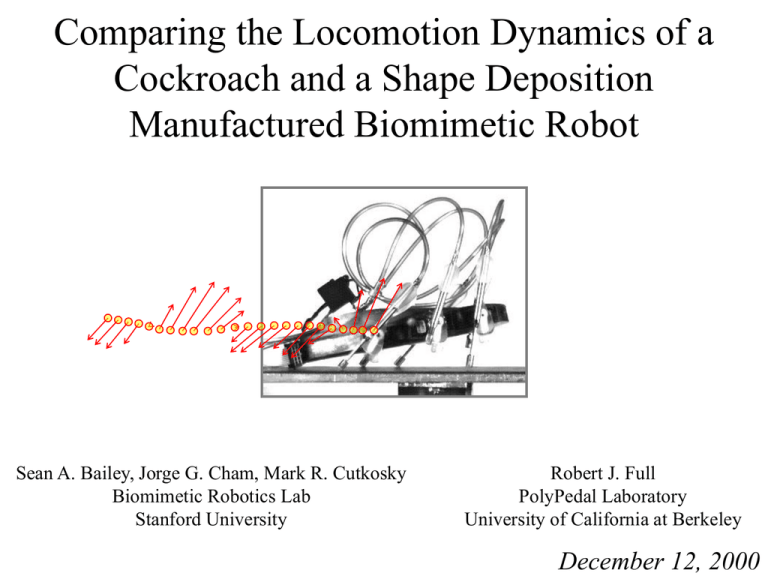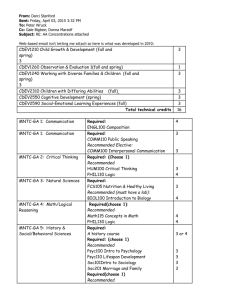Robust Dynamic Locomotion A clock
advertisement

Comparing the Locomotion Dynamics of a Cockroach and a Shape Deposition Manufactured Biomimetic Robot Sean A. Bailey, Jorge G. Cham, Mark R. Cutkosky Biomimetic Robotics Lab Stanford University Robert J. Full PolyPedal Laboratory University of California at Berkeley December 12, 2000 Overview • Introduction • Shape Deposition Manufacturing • Robot Design • Locomotion Dynamics • Conclusions Intro SDM Design Dynamics Conclusions Introduction • Motivation – Small – Fast – Robust De-mining in an unstructured environment • Integrated approach – Biomimetic structures – Biologically-inspired control Intro SDM Design Dynamics Conclusions Shape Deposition Manufacturing (SDM) Piston Fitting Inlet Valve Pressure Sensor Exhaust Valve Leaf-spring Manufacturing Prototype Limb with Embedded Pneumatic Actuator, Sensor, Leaf Spring and Valves Intro SDM Design Dynamics Conclusions Shape Deposition Manufacturing (SDM) • • • • • Arbitrary geometries Embedded components No fasteners Multi-materials Tailored compliance Graded, multi-material 5-bar Multi-material part w/ embedded components Intro SDM Design Dynamics Conclusions Biological Example • Death-head cockroach Blaberus discoidalis • Fast – Speeds of up to 10 body/s • Rough terrain – Can easily traverse fractal terrain of obstacles 3X hip height Blaberus discoidalis running over fractal terrain Intro SDM Design Dynamics Conclusions Biological Inspiration • Control heirarchy – Passive component – Active component Neural System (CPG) Sensory Feedback (Reflexes) Feedforward Motor Pattern Mechanical System (muscles, limbs) Mechanical Feedback (Preflexes) Environment Passive Dynamic Self-Stabilization Locomotion Intro Full and Koditschek, 1999 SDM Design Dynamics Conclusions Robot Design Cockroach Geometry Functional Biomimesis •Passive Compliant Hip Joint •Effective Thrusting Force •Rotary Joint •Prismatic Joint Robot Implementation •Damped, Compliant Hip Flexure •Embedded Air Piston Cham et al., 2000, Clark et al., 2001 Intro SDM Design Dynamics Conclusions Sprawlita • • • • Actuators and wiring embedded inside structure Mass - .27 kg Dimensions - 16x10x9 cm Leg length - 4.5 cm Max. Speed - 55 cm/s 3+ body/sec • Hip height obstacle traversal Intro SDM Legs with Compliant Flexures Design 2.5 cm Dynamics Conclusions Movie • Superficially insect-like • Stable running • Obstacle traversal Intro SDM Design Dynamics Conclusions Whole Body Dynamics 15 filtered vertical force unfiltered horizontal force Force (N) 10 • Force plate • High speed video 5 0 High speed video markers -5 450 550 650 750 Time (ms) Force Plate Data Force plate Locomotion Direction High-speed Footage with Markers Intro SDM Design Dynamics Conclusions Animal Running - the SLIP model SIX-Legged EIGHT- Legged Cockroach TWO-Legged Crab Body Weight Vertical Force FOUR- Legged Fore-aft Force Time Spring-Loaded Blickhan 1989 Inverted Pendulum SLIP Human Dog Cavagna et al., 1975 Intro SDM Design Dynamics Conclusions Whole Body Ground Reaction Forces Spring-Loaded Inverted Pendulum (SLIP) Blaberus discoidalis Sprawlita 6 0.025 4 Vertical Force 0.02 2 0.015 Fore-aft Force .004 2 0 0 -.004 -2 20 Time Decelerate Intro 40 60 80 0 Time (ms) Accelerate SDM Decelerate 100 Time (ms) Accelerate Design 50 Decelerate Dynamics Dragging Accelerate Conclusions Individual leg forces • Sprawlita drags middle and rear foot • Individual legs have functions dissimilar from cockroach legs Front Leg mN ms • More questions – Relative contact time N ms Middle Leg Hind Leg 12 10 10 0 0 0 -6 0 -6 140 0 60 -6 140 0 4 4 4 0 0 0 -2 0 50 -2 0 50 -2 0 140 20 50 filtered vertical force filtered horizontal force Dragging Intro SDM Design Dynamics Conclusions Summary and Conclusions • Sprawlita – Physically robust – Operationally robust – Open loop • Comparing locomotion dynamics suggests design improvements – Foot drag - longer stroke • If more SLIP-like... • faster? • more efficient? • more robust? Intro SDM Design Dynamics Conclusions Future Work • Sprawley Davidson • Leg extensions Valve • The Sprawlettes • High level, not real-time sensor-based control Cylinder Prototype with close proximity valve and cylinder Neural System (CPG) Sensory Feedback (Reflexes) Feedforward Motor Pattern Mechanical System (muscles, limbs) Mechanical Feedback (Preflexes) Environment Passive Dynamic Self-Stabilization Locomotion Intro Double piston extension SDM Design Dynamics SDM linkage extension Conclusions Acknowledgements • Stanford – Center for Design Research – Dexterous Manipulation Lab – Rapid Prototyping Lab • Berkeley – PolyPedal Lab • Sponsors – Office of Naval Research – National Science Foundation Intro SDM Design Dynamics Conclusions



